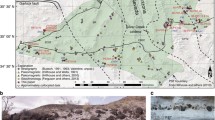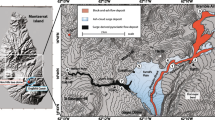Abstract
Pyroclastic flows from Unzen were generated by gravitational collapse of the growing lava dome. As soon as the parental lobe failed at the edge of the dome, spontaneous shattering of lava occurred and induced a gravity flow of blocks and finer debris. The flows had a overhanging, tongue-like head and cone- or rollershaped vortices expanding outward and upward. Most of the flows traveled from 1 to 3 km, but some flows reached more than 4 km, burning houses and killing people in the evacuated zone of Kita-kamikoba on the eastern foot of the volcano. The velocities of the flows ranged from 15 to 25 m/s on the gentle middle flank. Observations of the flows and their deposits suggest that they consisted of a dense basal avalanche and an overlying turbulent ash cloud. The basal avalanche swept down a topographic low and formed to tongue-like lobe having well-defined levees; it is presumed to have moved as a non-Newtonian fluid. The measured velocities and runout distances of the flows can be matched to a Bingham model for the basal avalanche by the addition of turbulent resistance. The rheologic model parameters for the 29 May flow are as follows: the density is 1300 kg/m3, the yield strength is 850 Pa, the viscosity is 90 Pa s, and the thickness of the avalanche is 2 m. The ash cloud is interpreted as a turbulent mixing layer above the basal avalanche. The buoyant portions of the cloud produced ash-fall deposits, whereas the dense portions moved as a surge separated from the parental avalanche. The ash-cloud surges formed a wide devastated zone covered by very thin debris. The initial velocities of the 3 June surges, when they detached from avalanches, are determined by the runout distance and the angle of the energy-line slope. A comparison between the estimated velocities of the 3 June avalanches and the surges indicates that the surges that extended steep slopes along the avalanche path, detached directly from the turbulent heads of the avalanches. The over-running surge that reached Kita-Kamikoba had an estimated velocity higher than that of the avalanche; this farther-travelled surge is presumed to have been generated by collapse of a rising ash-cloud plume.
Similar content being viewed by others
References
Beget JE, Limke AJ (1988) Two-dimensional kinematic and rheological modeling of the 1912 pyroclastic flow, Katmai, Alaska. Bull volcanol 50:148–160
Beget JE, Limke AJ (1989) Density and void ratio on emplacement of a small pyroclastic flow, Mount St. Augustine, Alaska. J Volcanol Geotherm Res 39:349–353
Davies DK, Quearry MW, Bonis SB (1978) Glowing avalanches from the 1974 eruption of the volcano Fuego, Guatemala. Geol Soc Am Bull 89:369–384
Denlinger RP (1987) A model for generation of ash clouds by pyroclastic flows, with application to the 1980 eruptions at Mount St. Helens, Washington. J Geophys Res 92(B10):10284–10298
Drake TG (1990) Structural features in granular flows. J Geophys Res 95(B6):8681–8696
Fisher RV (1979) Models for pyroclastic surges and pyroclastic flows. J Volcanol Geotherm Res 6:305–318
Fisher RV (1990) Transport and deposition of a pyroclastic surge across an area of high relief: the 18 May 1980 eruption of Mount St. Helens, Washington. Geol Soc Am Bull 102:1038–1054
Fisher RV, Heiken G (1982) Mt. Pelee, Martinique: May 8 and 20, 1902, pyroclastic flows and surges. J Volcanol Geotherm Res 13:339–371
Fisher RV, Schminke H-U (1984) Pyroclastic rocks. Springer, Berlin, Heidelberg, New York, Tokyo, pp 1–472
Francis PW, Roobol MJ, Walker GPL, Cobbold PR, Cowaed M (1974) The San Pedro and San Pablo volcanoes of northern Chile and their hot avalanche deposits. Geol Rundsch 63:357–388
Freundt A, Schminke H-U (1986) Emplacement of small-volume pyroclastic flows at Laacher See (East-Eifel, Germany). Bull Volcanol 48:39–59
Hiscott RN, Middleton GV (1979) Depositional mechanics of thick-bedded sandstones at the base of a submarine slope, Tourelle Formation (Lower Ordovician), Quebec, Canada. SEPM Spec Pub 27:307–326
Hoblitt RP (1986) Observation of the eruptions of july 22 and August 7, 1980, at Mount St. Helens, Washington. US Geol Surv Prof Pap 1335:1–44
Huppert HE, Turner JS, Carey SN, Sparks RSJ, Hallworth MA (1986) A laboratory simulation of pyroclastic flows down slopes. J Volcanol Geotherm Res 30:179–199
Ishida M, Hatano H, Shirai T (1980) The flow of solid particles in an aerated inclined channel. Powder Technology 27:7–12
Ishikawa Y, Yamada T, Yajima S, Mizuyama T (1991) Mechanism of pyroclastic flow, its numerical simulation method, and measures. Tech Memo PWRI 3005:73 p (in Japanese with English abstract)
Katayama N (1974) Old records of natural phenomena concerning the Shimabara Catastrophe. Sci Rpt Shimabara Earthquake Volcano Observ, Kyushu Univ 9:1–45 (in Japanese with English abstract)
Lowe DR (1976) Grain flow and grain flow deposits. J Sediment Petrol 46:188–199
Macdonald GA (1972) Volcanoes, Prentice-Hall Inc, Englewood Cliffs NJ, pp 1–510
McEwen AS, Malin MC (1989) Dynamics of Mount St. Helens' 1980 pyroclastic flows, rockslide-avalanche, Iahars, and blast. J Volcanol Geotherm Res 37:205–231
Mellors RA, Waitt RB, Swanson DA (198) Generation of pyroclastic flows and surges by hot-rock avalanches from the dome of Mount St. Helens volcano, USA. Bull Volcanol 50:14–25
Moore JG, Melson WG (1969) Nuees ardentes of the 1968 eruption of Mayon volcano, Philippines. Bull Volcanol 33:600–620
Nairn IA, Self S (1978) Explosive eruptions and pyroclastic avalanches from Ngauruhoe in February 1975. J Volcanol Geotherm Res 3:39–60
Nakada S, Tanaka M (1991) Magmatic processes of Unzen Volcano. Bull Volcanol Soc Jpn 36:113–121 (in Japanese with English abstract)
Nakada S, Aramaki S, Fujii T, Sumita M, Miyake Y (1992) Preliminary report of pyroclastic flow deposits of the 1991 eruption at Unzen Volcano. 1992 Jpn Earth Planet Sci Joint Meet Abst: 148 (in Japanese)
Research Group for Active Tectonics in Kyushu (1989) Active tectonics in Kyushu. Univ Tokyo Press, pp 1–553
Rodriguez-Elizarraras S, Siebe C, Komorowski J-C, Espindola JM, Saucedo R (1991) Field observations of pristine block-and ash-flow deposits emplaced April 16–17, 1991 at Volcan de Colima, Mexico. J Volcanol Geotherm Res 48:399–412
Rose WI Jr, Pearson T, Bonis S (1977) Nuee ardente eruption from the foot of a dacite lava flow, Santiaguito Volcano, Guatemala. Bull Volcanol 40:23–38
Saito E, Watanabe S, Suto S, Hoshizumi H, et al. (1991) Ground deformation of Unzen Volcano while 1990–91 eruption measured by electro-optical distance measurement. Volcano Soc Jpn Progr Abst 2:20 (in Japanese)
Sato H, Fujii T, Nakada S (1991) Fragmentation of dacite dome lava by excess pore pressure. Volcano Soc Jpn Progr Abst 2:48 (in Japanese)
Savage SB (1979) Gravity flow of cohesionless granular materials in chutes and channels. J Fluid Mech 92:53–96
Sheridan MF (1979) Emplacement of pyroclastic flows: a review. In: Chapin CE, Elston WE (eds) Ash-flow tuff. Geol Soc Am Spec Pap 180:125–136
Sheridan MF, Malin MC (1983) Application of computer-assisted map** to volcanic hazard evaluation of surge eruptions: Vulcano, Lipari, and Vesuvius. J Volcanol Geotherm Res 17:187–202
Siebert L, Glicken H, Ui T (1987) Volcanic hazards from Bezymianny-and Bandai-type eruptions. Bull Volcanol 49:435–459
Sparks RSJ (1976) Grain size variations in ignimbrites and implications for the transport of pyroclastic flows. Sedimentology 23:147–188
Sparks RSJ, Moore JG, Rice CJ (1986) The initial giant umbrella cloud of the May 18th, 1980, explosive eruption of Mount St. Helens. J Volcanol Geothermal Res 28:257–274
Sparks RSJ, Wilson L, Hulme G (1978) Theoretical modeling of the generation, movement, and emplacement of pyroclastic flows by column collapse. J Geophys Res 83(B4):1727–1739
Stith JL, Hobbs PV, Radke LF (1977) Observations of a nuee ardente from the St. Augustine volcano. Geophys Res Letters 4:259–262
Takarada S, Kazahaya K, Kawanabe Y, Sakaguchi K, et al. (1991) Volume estimation of 1991 eruption of Unzen Volcano and collapse mechanisms of pyroclastic flows at 6/3 and 6/8. Volcanol Soc Jpn Progr Abst 2:40 (in Japanese)
Tanaka M, Nakada S (1988) Geology of eastern part of Unzen Volcano. Sci Rpt Shimabara Earthquake Volcano Observ, Kyushu Univ 14:1–11 (in Japanese with English abstract)
Tanaka Y, Hashimoto T, Masuda H, Handa S, Utada H (1991) Geomagnetic changes related to the eruption of Unzen Volcano in 1991. Volcanol Soc Jpn Progr Abst 2:24 (in Japanese)
Ui T, Yamamoto H, Suzuki-Kamata K (1986) Characterization of debris avalanche deposits in Japan. In: Kushiro I (ed) M Sakuyama and H Fukuyama Memorial Volume. J Volcanol Geotherm Res 29:231–243
Valentine GA (1987) Stratified flow in pyroclastic surges. Bull Volcanol 49:616–630
Valentine GA, Wohletz KH (1989) Numerical models of Plinian eruptions and pyroclastic flows. J Geophys Res 94(B2):1867–1887
Wilson L, Head JW (1981) Morphology and rheology of pyroclastic flows and their deposits, and guidelines for future observations. In: Lipman PW, Mullineaux DR (eds) The 1980 eruptions of Mount St. Helens, Washington. US Geol Surv Prof Pap 1250:513–524
Wright JV, Smith AL, Self S (1980) A working terminology of pyroclastic deposits. J Volcanol Geotherm Res 8:315–336
Author information
Authors and Affiliations
Rights and permissions
About this article
Cite this article
Yamamoto, T., Takarada, S. & Suto, S. Pyroclastic flows from the 1991 eruption of Unzen volcano, Japan. Bull Volcanol 55, 166–175 (1993). https://doi.org/10.1007/BF00301514
Received:
Accepted:
Issue Date:
DOI: https://doi.org/10.1007/BF00301514




